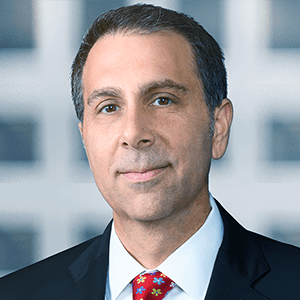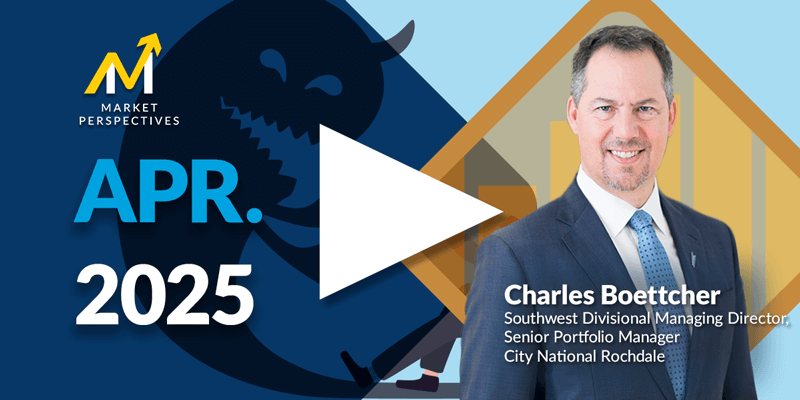-
Fixed Income Perspectives
Tariffs Bring Volatility & Opportunity to the Bond Market
April 2025
- Filename
- Fixed Income Perspectives April 2025.pdf
- Format
- application/pdf
TRANSCRIPT
Although it's been two weeks since we wrapped up the first quarter, it seems more distant, as market volatility is keeping investors busy navigating an uncertain trade policy landscape. The quick changes in sentiment over the past few days have refocused attention away from the solid performance of most fixed income asset classes in the first quarter.
To recap, January and February benefited from declining rates and strong investor demand. That gave way to a weaker March, as economic and tariff risks became more pronounced.
Fixed Income Asset Class Performance

Source: Morningstar Leveraged Loan 100 Index, Bloomberg US Corporate High Yield Index, ICE BofA Diversified High Yield EM Corporate Plus Index, Palmer Square BB CLO Index, Bloomberg Municipal Bond Index, Bloomberg US Treasury Index, Bloomberg High Yield Municipal Bond Index and Bloomberg US Corporate Investment Grade Index as of 3/31/2025.
Past performance is not a guarantee of future results.
Chart 1, 0:45– U.S. treasuries posted strong returns near 3%, while investment grade corporates and high yield emerging market debt closely followed with around 2.3%. Even though investment grade municipals were slightly negative, the decline in prices has created compelling income opportunities that should persist for some time. As the second quarter gets underway, elevated volatility across most asset classes is reminiscent of the great financial crisis of 2008. The unexpected changes in trade policy are a primary driver, with President Trump's Liberation Day resulting in steeper tariffs than what was initially expected by investors. Market reaction was sharply negative across most asset classes, with the S&P 500 declining by as much as 12%.
However, after the administration paused most tariffs for 90 days, apart from those with China, the tone of the market has improved, but the tension between the U.S. and China is likely going to continue to be disruptive to global financial markets. The lack of clarity surrounding policy direction has led U.S. treasuries to trade in historically wide intraday ranges. 10-year and 30-year treasury bonds have been as wide as 70 basis points, a level last observed during the early days of the pandemic. For example, after reaching a low of 4% in early April, the 10-year U.S. Treasury increased about 50 basis points within a few days.
Speculation surrounding these abrupt moves in Treasury rates has been attributed to several factors, such as deleveraging and diminished foreign buyer support. In our view, recent movements in Treasury rates reflect the interplay between domestic policy decisions and broader economic concerns surrounding inflation and projected federal deficits.
US Corporate Investment Grade and High Yield Spreads (in bps)

Source: Bloomberg US Aggregate Corporate Average OAS and Bloomberg US High Yield Corporate Average OAS as of 4/15/2025.
Information is subject to change and is not a guarantee of future results.
Chart 2, 2:38– These themes will play out in the coming weeks and months, and they will impact the credit markets unevenly, especially if the economic growth forecasts become less clear. Over the past few weeks, credit spreads for investment grade and high yield U.S. corporate bonds have widened from their multi year lows, but they have recently found a more stable footing. For instance, investment grade and high yield U.S. corporate spreads peaked at 120 and 455 basis points, but now they're trading somewhat tighter. Since early March, both investment grade and high yield mutual funds have reported volatility-induced redemptions on a scale last observed as early as 2023. But while outflows ordinarily lead to spread widening, corporate credit quality remains intact, with healthy balance sheets and manageable leverage. As corporate earnings season gets underway, we are carefully monitoring how near-term guidance is changing to the uncertainty of trade policy.
10-Year US Treasury

Source: Bloomberg U.S. Treasury Index 10-Year as of 4/15/2025
Information is subject to change and is not a guarantee of future results.
Chart 3, 3:26– In municipals, the change in benchmark yields has been eye-catching, with bonds repricing higher by as much as a 100 basis points across the curve over a three-day period. However, the sharp move was not credit-related, but a technical event where liquidity needs from ETFs and other sellers disrupted the market. In fact, municipal bond credit quality spreads have remained somewhat range bound since the beginning of the year, but the underperformance of municipals versus U.S. treasuries has resulted in valuations exceeding their five-year historical averages, with available yields now offering a more compelling entry point for long-term investors. In closing, policy-induced market volatility is likely to continue.
We anticipate regulatory and tax reform to gain more bandwidth as the House and Senate deliberate proposals in the coming weeks and months. For more than a year, we have held the view that rates will remain structurally higher for longer and forecast the 10-year treasury to remain range bound between 4% and 4.5%. We think the Fed is likely to remain patient as it awaits data on how current trade policy decisions may impact inflation and labor market strength. However, we do anticipate one to two rate cuts by year end.
Important Information
The views expressed represent the opinions of City National Rochdale, LLC (CNR) which are subject to change and are not intended as a forecast or guarantee of future results. Stated information is provided for informational purposes only, and should not be perceived as personalized investment, financial, legal or tax advice or a recommendation for any security. It is derived from proprietary and non-proprietary sources which have not been independently verified for accuracy or completeness. While CNR believes the information to be accurate and reliable, we do not claim or have responsibility for its completeness, accuracy, or reliability. Actual results, performance or events may differ materially from those expressed or implied in such statements.
All investing is subject to risk, including the possible loss of the money you invest. As with any investment strategy, there is no guarantee that investment objectives will be met, and investors may lose money. Diversification does not ensure a profit or protect against a loss in a declining market. Past performance is no guarantee of future performance.
City National Rochdale, LLC is an SEC-registered investment adviser and wholly-owned subsidiary of City National Bank. Registration as an investment adviser does not imply any level of skill or expertise. City National Bank is a subsidiary of the Royal Bank of Canada.
Fixed Income investing strategies & products. There are inherent risks with fixed income investing. These risks include, but are not limited to, interest rate, call, credit, market, inflation, government policy, liquidity or junk bond risks. When interest rates rise, bond prices fall. This risk is heightened with investments in longer-duration fixed income securities and during periods when prevailing interest rates are low or negative.
Index Definitions:
Bloomberg U.S. Treasury Index: includes all publicly issued, U.S. Treasury securities that are rated investment grade, and have $250 million or more of outstanding face value.
Bloomberg 1-3 Month U.S. Treasury Bill/T-Bill Index (the "Index") is designed to measure the performance of public obligations of the U.S. Treasury that have a remaining maturity of greater than or equal to 1 month and less than 3 months.
Bloomberg U.S. Intermediate Corporate Bond Index measures the performance of U.S. corporate bonds with a maturity of 1–10 years. It's part of the Bloomberg U.S. Corporate Index.
The Bloomberg Municipal Bond: Muni Inter-Short (1-10) Index is a measure of the US municipal tax-exempt investment grade bond market. It includes general obligation and revenue bonds, which both can be pre-refunded years later and get reclassified as such. The effective maturity of the bonds in the index must be greater than or equal to 1 years but less than 10 years.
Bloomberg U.S. Municipal High-Yield Index: covers the U.S.-dollar denominated, non-investment grade, fixed-rate, municipal bond market and includes securities with ratings by Moody’s, Fitch and S&P of Ba1/BB+/BB+ or below.
The Bloomberg US Corporate High Yield Index measures the performance of non-investment grade, US dollar-denominated, fixed-rate, taxable corporate bonds.
ICE BofA Diversified High Yield US Emerging Markets Corporate Plus Index tracks the performance of US dollar denominated below investment grade emerging markets non-sovereign debt publicly issued in the major domestic and Eurobond markets.
The Palmer Square CLO Debt Index (“CLO Debt Index”) (ticker: CLODI) is a rules-based observable pricing and total return index for collateralized loan obligation (“CLO”) debt for sale in the United States, original rated A, BBB, or BB or equivalent.
US Corporate Short 1-5 refers to short-term US corporate bonds with 1–5 years remaining until maturity. These bonds are part of the investment-grade corporate bond market, which is dominated by financial services issuers.
Municipal Short 1-5 refers to a collection of municipal bonds that mature between one and five years. These bonds are a type of debt obligation that pay interest that is exempt from federal income tax.
U.S. Corporate Intermediate 1-10 refers to investment-grade corporate bonds that mature between one and ten years. These bonds are denominated in U.S. dollars and are taxable.
Municipal Short/Intermediate 1-10 is a term used to describe a group of US tax-exempt municipal bonds that have a maturity date between one and ten years. These bonds can be used in a variety of investment strategies, including bond ladders and managed accounts.
© 2025 City National Rochdale, LLC. All rights reserved.
Stay Informed.
Get our Insights delivered straight to your inbox.
Put our insights to work for you.
If you have a client with more than $1 million in investable assets and want to find out about the benefits of our intelligently personalized portfolio management, speak with an investment consultant near you today.
If you’re a high-net-worth client who's interested in adding an experienced investment manager to your financial team, learn more about working with us here.



